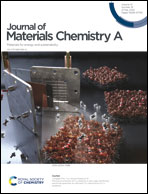Applications of advanced metrology for understanding the effects of drying temperature in the lithium-ion battery electrode manufacturing process†
Abstract
The performance of lithium-ion batteries is determined by the architecture and properties of electrodes formed during manufacturing, particularly in the drying process when solvent is removed and the electrode structure is formed. Temperature is one of the most dominant parameters that influences the process, and therefore a comparison of temperature effects on both NMC622-based cathodes (PVDF-based binder) and graphite-based anodes (water-based binder) dried at RT, 60, 80, 100 and 120 °C has been undertaken. X-ray computed tomography showed that NMC622 particles concentrated at the surface of the cathode coating except when dried at 60 °C. However, anodes showed similar graphite distributions at all temperatures. The discharge capacities for the cathodes dried at 60, 80, 100 and 120 °C displayed the following trend: 60 °C < 80 °C < 100 °C < 120 °C as C-rate was increased which was consistent with the trends found in adhesion testing between 60 and 120 °C. Focused-ion beam scanning electrode microscopy and energy-dispersive X-ray spectroscopy suggested that the F-rich binder distribution was largely insensitive to temperature for cathodes. In contrast, conductivity enhancing fine carbon agglomerated on the upper surface of the active NMC particles in the cathode as temperature increased. The cathode dried at RT had the highest adhesion force of 0.015 N mm−1 and the best electrochemical rate performance. Conversely, drying temperature had no significant effect on the electrochemical performance of the anode, which was consistent with only a relatively small change in the adhesion, related to the use of lower adhesion water-based binders.



 Please wait while we load your content...
Please wait while we load your content...